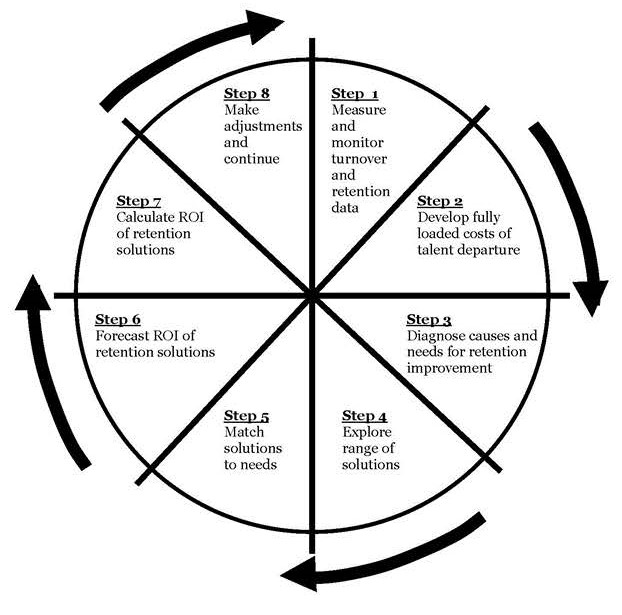Your cart is currently empty!
Managing Talent Retention
By Patti P. Phillips, Ph.D., and Jack J. Phillips, Ph.D.
Talent retention is a critical issue in most organizations. The challenge is to understand turnover costs and causes clearly. Often, top leaders misunderstand what causes turnover. Is it pay? Is it a lack of flexible working hours? Lack of engagement or career opportunities? Something else? The key is identifying the cause of turnover and clearly understanding the solutions. At the same time, a forecast of the ROI for a solution may be needed.
Problems with current approaches
The approaches used to manage retention have created several problems. How many of these issues sound familiar?
Proactive versus reactive (What problem?)
Too many organizations react to the retention issue — waiting until a serious problem surfaces, often developing enormous incentive packages to entice key employees to “stay with the ship.” Excessive turnover causes severe stresses and financial impact. A proactive approach is needed to prevent the issue from surfacing. This is often easier said than done. Almost every manager will agree talent departure should be prevented before it becomes a problem.
Developing too many preventive programs (If we try this, and this, and this, we can prevent the problem in the future)
Just as the reactive approach can be a problem, implementing too many preventive programs can also be a problem. To be proactive, many organizations implement preventive programs with a “try it and see” mentality without understanding their real impact. Meanwhile, far too much money is spent.
Searching for solutions (Hey, they have a great program at the Hard Rock Cafe´!)
Many HR managers are continually searching for a solution, trying to find a program that has worked for another organization. Many times, this approach results in failure. Searching for a solution without the proper analysis of the problem leaves the management team wondering whether there is a solution in their situation.
Too many solutions (I’ve never met a solution I didn’t like!)
Even when employee retention is identified as a problem, far too many organizations base their approach on an excessive number of solutions. Turnover is a complex issue with many influences. The published literature on retention doesn’t help — often offering countless solutions. An excessive number of new programs can result in costly efforts with minimal, if any, results to show for them.
Mismatches between need and solution (We blew it on this one!)
Too often, a solution that doesn’t address the need or problem is implemented. Perhaps there is insufficient information to provide a clear understanding of the solution required. Perhaps the wrong solution is selected or improperly implemented, resulting in a lack of added value. The solution may not be addressing the need as anticipated.
Lack of payoff (What results?)
When an expensive solution is implemented, taking precious time and resources, the management team wonders whether it made a difference. Did it add enough value to offset the costs of its implementation? Could a different, less expensive solution have similar results? Is the turnover rate still unacceptable? The solution might have successfully prevented further turnover deterioration, or it could have left turnover unchanged, poised for further deterioration. The problem lies in not knowing. A process is needed to measure the results of a solution from a balanced perspective, collecting data (tangible and intangible) so management can clearly see the impact of major retention strategies.
Needed: An ROI approach
These problems and the rationale for preventing them form the basis for the approach presented in Figure 1. The ROI approach to manage talent retention in eight steps positions retention as part of strategy. The executive team is involved in the retention issue. With many firms, retention has become a strategic issue because it makes the difference between financial mediocrity and excellence.
 Figure 1. ROI approach to managing talent retention
Figure 1. ROI approach to managing talent retention
Retention issues are measured with bottom-line results including ROI, as the approach moves logically from one issue to another. The approach has a discipline and a methodology and is a continuous cycle of improvement.
Ultimately, the approach positions the organization in a preventive stance working to maintain the appropriate level of staffing and reducing the risk of turnover. Each segment of the ROI approach is briefly discussed in this article.
- Measure and monitor turnover data
For many organizations, it’s voluntary turnover. For others, it includes resignations and terminations based on unsatisfactory performance and is labeled “avoidable turnover,” but is difficult to monitor. Ideally, it is regrettable turnover. These departures are high performers, high potentials or employees in critical jobs. The important point is to select the proper definition and use it appropriately to compare with others.
- Develop fully loaded costs of talent departure
The cost of turnover is one of the most underestimated and undervalued HR costs. It is often misunderstood because it does not reflect the actual costs of a turnover statistic and costs are not regularly reported to management. It can be alarming to management when fully loaded costs are calculated for the organization for an entire year. Figure 2 provides a more comprehensive listing that includes 12 categories.
| · Exit costs
· Recruiting costs · Employment cost · Orientation/on-boarding cost · Job-related training cost · Compensation while training |
· Lost productivity
· Quality problems · Customer dissatisfaction · Loss of expertise/knowledge · Management time for turnover · Temporary replacement costs |
Figure 2. Recommended categories for accumulating turnover costs
But when the cost of turnover is developed, it is usually presented as a percent of annual pay for the job group because many of the cost items relate to salaries. This prevents constant updating of the data as salaries increase. Figure 3 presents a summary of turnover costs for studies of several job groups. The costs are rounded up with a range for the job group.
| Job Type/Category | Turnover Cost Ranges as a Percent of Annual Wage/Salary |
| Entry Level – Hourly, Non-skilled, e.g., Fast Food Worker Service/Production Workers – Hourly, e.g., Courier
Skilled Hourly, e.g., Machinist Clerical/Administrative, e.g., Scheduler Professional, e.g., Sales Representative, Nurse, Accountant Technical, e.g., Computer Technician Engineers, e.g., Chemical Engineer Specialists, e.g., Computer Software Designer Supervisors/Team Leaders, e.g., Section Supervisor Middle Managers. e.g., Department Manager |
30 – 50%
40 – 70% 75 – 100% 50 – 80% 75 – 125% 100 – 150% 200 – 300% 200 – 400% 100 – 150% 125 – 200% |
Figure 3. Turnover costs summary
- Diagnose causes and needs for retention improvement
Determining the cause of turnover is a critical and illusive issue. Collecting appropriate data is often a challenge because of the potential for bias and inaccuracies that surface during data collection. Several diagnostic processes are available.
Figure 4 shows an initial list of diagnostic tools to use with turnover analysis, beginning with analyzing trends and patterns in particular groups and demographic categories to pinpoint the problem area. The tools range from a survey to a focus group to uncover the causes of turnover. Because of this critical issue, a case study using the nominal group technique may be helpful.
| • Diagnostic tools
• Demographic analysis • Diagnostic instruments • Focus groups • Probing interviews • Job satisfaction surveys • Organizational commitment surveys • Exit interviews |
• Exit surveys
· Nominal group technique • Brainstorming • Cause-and-effect diagram • Force field analysis • Mind mapping • Affinity diagrams • And the list continues |
Figure 4. tools to diagnose turnover problems
- Explore a range of solutions
Organizations are creative in their approach to the turnover problem, resulting in hundreds of excellent solutions. Confusion may develop because there are so many potential solutions to a problem. The critical issue is to ensure the solution is feasible for the organization.
- Match solutions to needs
This step goes with forecasting the value of solutions presented next. The development of the two issues should be parallel because the solutions selected for implementation are assumed to meet specific needs, making the forecast of the anticipated value important. When attempting to match solutions to need, avoid mismatches and multiple solutions. Also, select a solution for a maximum return and verify the match early.
- Forecast ROI of the retention solutions
Developing a forecast for the value of a solution allows the team to establish priorities, work with a minimum number of solutions and focus on solutions with the greatest ROI. Forecasting is expert estimation of what a solution should contribute. The ROI value can be developed if the percentage of expected turnover reduction can be related to a solution.
For example, if the number-one cause of turnover is addressed with a solution, what percentage of the turnover would be avoided? The “experts” who make the forecast should be knowledgeable about the solution (content) and the workplace where turnover is occurring (context). Ideally, the forecast should contain an expected ROI value. However, a more realistic approach is to offer a range of possible ROI values, given certain assumptions, removing some of the risk of making a precise estimation.
- Calculate ROI of retention solutions
Another often-neglected step is the calculation of the impact of a turnover reduction strategy. This step is often omitted because it appears to be an add-on process. From a senior executive’s point of view, accountability is not complete until impact and ROI data have been collected, at least for major solutions. The ROI process described here generates six types of data about the success of a turnover-reduction strategy:
- Reaction to the solution
- Skill and knowledge acquired to implement the solution
- Application and implementation to make the solution work
- Business impact improvement (turnover reduced or prevented)
- Return on investment, expressed as a financial ROI formula
- Intangible measures, not converted to monetary values.
This strategy also includes a technique to isolate the effects of the retention solution.
The ROI process has achieved widespread applications for the evaluation of all types of programs and solutions. It involves a series of steps collecting the six types of data at different time frames and processing the data in a logical, rationale approach, as shown in Figure 5.
This ROI process is comprehensive and accurate and can provide assessment of the impact of any turnover-reduction strategy. However, because of the time and effort required, the process should not be applied to every turnover-reduction program. Only those solutions considered to be expensive, time-consuming, high profile and closely attached to organizational goals should be considered for this type of analysis.
Figure 5. The ROI Methodology
- Adjust and continue
The extensive set of data collected from the ROI process will provide information to adjust turnover-reduction strategies. The information reveals success of the turnover-reduction solution at all levels from reaction to ROI. It also examines barriers to success, identifying specifically what prevented it from becoming more effective. It also identifies the processes in place that enable or support a turnover-reduction solution. All information provides a framework for adjusting and/or repositioning the solution so it can be revised, discontinued or amplified. The next step goes back to the beginning — monitoring data to ensure turnover continues to meet expectations — and the cycle continues.
This approach to managing retention has many inherent advantages and is highly recommended when there is concern with preventing or reducing turnover. It is comprehensive, disciplined and focuses on results throughout the process as retention is tackled in a productive and efficient way. Please contact ROI Institute for an example of a forecast of a turnover solution (Family Mutual Insurance) and a case study illustrating the use of the nominal group technique (Southeast Corridor Bank).
This article was originally published by Talent Management on February 23, 2022.


























